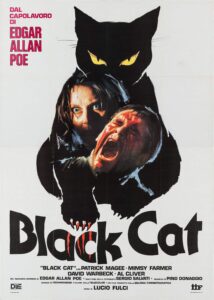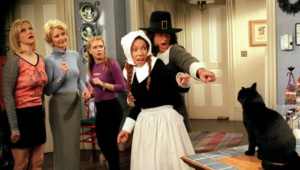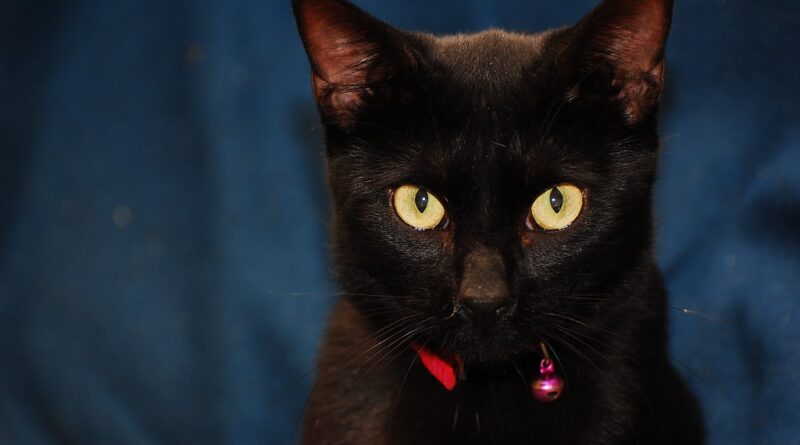Feline Folklore: The Dark Legacy and Modern Redemption of Black Cats in Halloween Pop Culture
On a crisp October night around six in the evening, you begin to unbox your Halloween decorations in preparation for your annual celebration. As you are opening the dust-coated bins, you begin to notice an abundance of decor in the shape of black cats! You ask yourself, what’s so frightening about such an adorable animal? You’d be surprised to find out the deep, dark history surrounding these now domesticated creatures and how they have been used as a symbol of death and despair throughout pop culture history.
Typically, when one walks into a PetSmart or animal shelter, they don’t jump to conclusions about an animal’s personality based on their coat color. However, one may be surprised to hear that black cats have the highest euthanasia rate, at 74.6%, and the lowest adoption rate, at just 10.0% according to the National Library of Medicine. This harsh reality for our friendly, fluffy friends is due to folktales and myths surrounding Medieval witchcraft! During the Middle Ages, black cats became associated with black magic and were thought to be demons sent by witches to spy on the common folk. The Spruce Pets, a veterinarian-backed blog, claims that In Italy throughout the 16th century, it was believed that if a black cat crossed one’s path they would be cursed and die! This superstition and others alike led to mass killings of these animals in Europe, specifically during the Great Plague. Medical and scientific technology was not advanced enough at this time for people to understand why sickness was spreading so rapidly. Therefore, they turned the blame on anything and everything they could, including these harmless creatures.
As hysteria arose, black cats were heavily stigmatized, leading to yet another mass killing in the 17th century during the Salem Witch Trials. Over 300 years later, black cats are continuously harassed and negatively portrayed during the Halloween season, along with being less likely to be adopted from a shelter year-round. This unfortunate fate has continued for our shadowy friends due to their portrayal in the media, in which many of the superstitions derived from folklore shine through.

As film became a dominant pop culture force in the early 1900s, most horror movies used black cats as evil or antagonistic figures. Edgar Allen Poe’s story The Black Cat has been used multiple times as inspiration for films where the main antagonist is a black cat. For instance, The Black Cat (1981) directed by Lucio Fulci, features a murderous cat who kills simply through its gaze. In the first scene, this cat causes a man to get in a fatal car accident. Then, the cat scratches a man who is trying to flee from the animal, causing him to lose his balance and fall to his death. In both instances, the animal is portrayed as murderous and widely feared by the other characters in the film. This notion of black cats going on homicidal sprees stems from the idea that witches would use black cats as a disguise to curse and kill villagers.
Another film in which an evil black cat harms seemingly innocent characters is The Legend of Hell House (1973), directed by John Hough. This film includes a specific scene where a woman is getting ready in her room when suddenly, a black-coated cat walks through the door and proceeds to jump on her, scratching her chest, drawing blood, and causing a commotion. This scene is important because later in the film, another character accuses the woman attacked of self-mutilation; therefore, the cat has no significant role besides hurting the woman. The cat does not meaningfully add to the storyline as there are many other ways the woman could have been injured and got those scratches. Though this is a more minor example compared to The Black Cat, it goes to show that this animal was portrayed as evil for no valuable reason due to its coat color.
Another movie inspired by Poe’s works is The Tomb of Ligeia, released in 1964. It follows the story of a widow who is “haunted” by the reincarnation of his wife in the form of a black cat. The woman’s husband, grieving and angry, locks himself away from the rest of the world. However, when he goes to visit his wife’s grave, he encounters a young woman who begins to express interest in him. He eventually goes on to marry this woman and she moves in with him. While living in the home, a black cat wounds and attempts to kill the woman several times! In the end, the widow must face his dead wife in her feline form where they are both violently injured. Again, instead of choosing a cat of another coat color to be portrayed as evil and violent, the cat in this film is black. The cat is also a human soul taking feline form, which aligns closely with the folklore story of witches possessing black cats to do evil deeds.

In spite of the poor representation throughout the 20th century, the media has seen many heroic and humorous black cats in more recent times. For instance, Snowball II in the hit series The Simpsons (1989) is generally loyal to the family and a pretty average, silly black cat. He has little to no evil tendencies, though he is rather witty. In one of his final scenes, he is a hero and sacrifices his life for Marge! By jumping into the air at the perfect time, he intercepts a knife that is thrown her way. Rather heroic, if you ask me. One of the most popular black cats out there is Salem from Sabrina the Teenage Witch (1996). Salem is initially possessed by witches and cursed to be a black cat, however, he is not evil and is a very good companion to Sabrina. Salem also has a very witty sense of humor, making him a valuable and recognizable character throughout the course of the show. Many heroic witches like Sabrina have cat companions as they are an important symbol in pop culture, such as Hermione Granger and her cat Crookshanks! In a multitude of examples, cats are helpful and supportive companion characters, contributing to the 21st-century reappraisal of witches and black cats.
Another well-known feline friend is Thackery Binx from Hocus Pocus. Binx is turned from a human boy to a black cat by the witches themselves and is associated with rather evil concepts like witchcraft and possession. However, he turns out to be a very smart, helpful, and social character. He protects the Sanderson sisters’ home from being cursed and is their tiny, fluffy bodyguard in a way. His peak “superhero” moment is when he leads the escape from the witches’ house in which characters Dani, Max, and Allison are trapped. Thackery is the hero of the story in this case, rather than bringing about the bad luck that black cats typically represent.

Black cats are unfairly scrutinized each Halloween season, despite them being completely harmless. The evilest thing these furry shadow creatures will ever do is swat at you when they are overstimulated or maybe bring you a gift in the form of a dead rodent, which is something all cats do. Black cats are harmless creatures who deserve respect year-round, no matter the color of their coat. So this Halloween season, as you’re passing the best-decorated houses, remind yourself of the harsh reality that our fluffy friends face all due to some silly medieval stories. And if you have the means, adopt a dark-coated baby from your local animal shelter, as they have likely been turned down one too many times.

